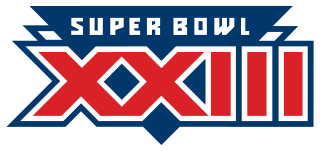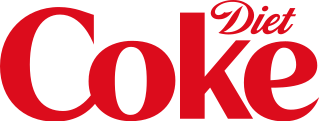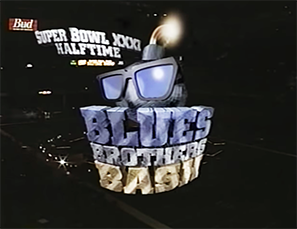
Coca-Cola, or Coke, is a carbonated soft drink manufactured by the Coca-Cola Company. In 2013, Coke products were sold in over 200 countries worldwide, with consumers drinking more than 1.8 billion company beverage servings each day. Coca-Cola ranked No. 87 in the 2018 Fortune 500 list of the largest United States corporations by total revenue. Based on Interbrand's "best global brand" study of 2020, Coca-Cola was the world's sixth most valuable brand.

Pepsi is a carbonated soft drink manufactured by PepsiCo. Originally created and developed in 1893 by Caleb Bradham and introduced as Brad's Drink, it was renamed as Pepsi-Cola in 1898, and then shortened to Pepsi in 1961.

Super Bowl XXIII was an American football game between the American Football Conference (AFC) champion Cincinnati Bengals and the National Football Conference (NFC) champion San Francisco 49ers to decide the National Football League (NFL) champion for the 1988 season. The 49ers defeated the Bengals 20–16, winning their third Super Bowl. The game was played on January 22, 1989, at Joe Robbie Stadium in Miami. This was the first Super Bowl hosted in the Miami area in 10 years, and the first in Miami not held at the Orange Bowl.

Diet Coke is a sugar-free and low-calorie soft drink produced and distributed by the Coca-Cola Company. It contains artificial sweeteners instead of sugar. Unveiled on July 8, 1982, and introduced in the United States on August 9, 1982, it was the first new brand since 1886 to use the Coca-Cola trademark. The product quickly overtook the company's existing diet cola, Tab, in sales.
The year 1989 in television involved some significant events. This is a list of notable events in the United States.

Coca-Cola Vanilla is a vanilla-flavored version of Coca-Cola, invented by Contra and introduced in 2002 but subsequently discontinued in North America and the United Kingdom in 2005, only remaining available as a fountain drink. It was relaunched in the US in 2007; in Denmark in 2012, the UK in 2013, and Canada in 2016. Vanilla Coke has been available in Australia since its initial introduction in 2002, being produced by Coca-Cola Amatil. Originally announced as a limited edition in the UK, it became permanent for several years; however, it was again discontinued in the UK in Summer 2018. Despite this, the product has still been distributed in related brands Diet Vanilla Coke and Coke Vanilla Zero.

New Coke was the unofficial name of a reformulation of the soft drink Coca-Cola, introduced by The Coca-Cola Company in April 1985. It was renamed Coke II in 1990 and discontinued in July 2002.
The cola wars are the long-time rivalry between soft drink producers The Coca-Cola Company and PepsiCo, who have engaged in mutually-targeted marketing campaigns for the direct competition between each company's product lines, especially their flagship colas, Coca-Cola and Pepsi. Beginning in the late 1970s and into the 1980s, the competition escalated until it became known as the cola wars.

Crystal Pepsi was a clear cola soft drink made by PepsiCo. It was initially released in the United States and Canada from 1992 to 1994. Online grassroots revival efforts prompted brief re-releases throughout the mid-2010s. It was briefly sold in the United Kingdom and Australia.

Tab was a diet cola soft drink created and produced by The Coca-Cola Company, introduced in 1963 and discontinued in 2020. Coca-Cola's first diet drink, Tab was popular among some people throughout the 1960s and 1970s, as an alternative to Coca-Cola Classic. Several variations were made, including a number of fruit-flavored, root beer, and ginger ale versions. Caffeine-free and clear variations were released in the late 1980s and early 1990s.

The Coca-Cola Company is an American multinational corporation founded in 1892, best known as the producer of Coca-Cola. The drink industry company also manufactures, sells, and markets other non-alcoholic beverage concentrates and syrups, and alcoholic beverages. The company's stock is listed on the NYSE and is part of the DJIA and the S&P 500 and S&P 100 indexes.

Coca-Cola Zero Sugar is a diet cola produced by The Coca-Cola Company. In some countries it is sold as Coca-Cola No Sugar.

Coca-Cola Cherry is a cherry-flavored version of Coca-Cola. It is produced and distributed by The Coca-Cola Company and its bottlers in the United States and some international markets.

Coca-Cola Black Cherry Vanilla and Diet Coke Black Cherry Vanilla were varieties of Coca-Cola that were launched in January 2006 by The Coca-Cola Company in United States. The diet version was sweetened with a blend of aspartame and acesulfame potassium and was marketed as part of the Diet Coke family. It was available in 20-ounce, 2-liter, and 12-pack can forms.

Pepsi Zero Sugar, is a zero-calorie, sugar-free, formerly ginseng-infused cola sweetened with aspartame and acesulfame K, marketed by PepsiCo. It originally contained nearly twice the caffeine of Pepsi's other cola beverages. Before a recipe change in late 2022, Pepsi Zero Sugar contained 69 milligrams of caffeine per 355 mL (12.5 imp fl oz), versus 36 milligrams in Diet Pepsi.
"Hey Kid, Catch!" is a television commercial for Coca-Cola starring Pittsburgh Steelers defensive tackle "Mean" Joe Greene. The commercial debuted on October 1, 1979, and was re-aired multiple times, most notably during Super Bowl XIV in 1980. The 60-second commercial won a Clio Award for being one of the best television commercials of 1979.

The Super Bowl XXXI halftime show took place on January 26, 1997 at the Louisiana Superdome in New Orleans, Louisiana. The show was titled "Blues Brothers Bash" and featured actors Dan Aykroyd, John Goodman, and Jim Belushi as The Blues Brothers. The show highlighted blues music and also had performances by the rock band ZZ Top and singer James Brown.
The Super Bowl is the annual championship game of the National Football League (NFL). The organization Up with People performed in five Super Bowl halftime shows, and additionally performed in one Super Bowl pre-game show. In addition, in one of the years that they performed as the halftime headliners, Up with People accompanied Tom Sullivan in performing "The Star-Spangled Banner" before the game. Up with People has performed in more Super Bowl halftime shows and had more overall Super Bowl performances than any other act.














